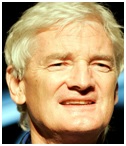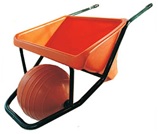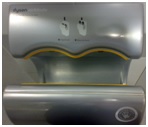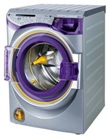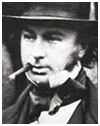|
 |
|
 |
|
|
||
James Dyson - Creativity and Innovation
James Dyson (1947- )
English inventor (pictured right) of the bagless vacuum cleaner (the Dual Cyclone), first sold in 1993. Another of his inventions was the ballbarrow (pictured right below), a wheelbarrow with a ball instead of a wheel. Why is he so creative?
1. Passionate purpose He has always passionately pursued his desire to:
2. Inspiration The idea for the Dual Cyclone (pictured right) came from a visit to a saw mill near Bath in England in 1978, which was using a huge cyclone (or cone), to spin off dust, not suck it in. He rushed home and made the world’s first bagless vacuum cleaner with a cardboard cyclone!
3. Persistence, patience and experimentation Dyson believes in “constructive failure”, learning from failure and gradual change on the road to success. It took 5,127 prototypes and 15 years to make the Dual Cyclone. He spent two years trying unsuccessfully to sell it to all the big producers like Hoover. So he had to make it in his own factory in Malmesbury, Wiltshire. “An overnight success takes years of effort”, he says. He was driven by:
4. Risk taking and continuous improvement He had to borrow millions to make his vacuum cleaner, and all his wealth is tied up in the business. Despite his $1 billion fortune, he still spends most days in his workshop:
For example, his new products include:
5. Learning He learns from a) existing products (things they do badly or not at all)
b) comments from his employees and customers He only believes what he discovers not what people tell him. c) his failures (like his washing machine, the Contrarotator, pictured right, which was innovative but too expensive).
6. Customer satisfaction His vacuum cleaner has been a huge global success - why? a) happy customers Satisfying people’s needs better than competitors:
Dyson doesn’t totally rely on market research, because it only tells him what customers want now, not what they might need in the future.
b) knowing customers The British vacuum market is split evenly between:
c) thinking global Dyson sells in all the big world markets
The Japanese like pink and the Americans love
d) word of mouth People telling each other about his vacuum cleaner has been its biggest sales booster.
e) advertising (using the slogan “say goodbye to the bag”) .
f) after-sales service His products are guaranteed and can be replaced within 24 hours.
g) style and design People love his cleaner’s bright colours In America it has become a fashion item, encouraging men to do the cleaning! h) branding The Dyson brand is cool and has appeared on the TV comedy, Friends (the cast is pictured right in the first 1994 series).
i) novelty His bagless cleaner was revolutionary and the first on the market.
j) combining different management skills New product development involves:
7. Creative thinking Like his hero, Isambard Kingdom Brunel (pictured right), Dyson always:
8. Self-confident and tough Dyson: a) has always had total confidence in his products, b) takes people to court for copying his inventions (to “defend what is yours”, he says). c) is tough enough to make difficult decisions (like transferring his factory to Malaysia in 2002).
9. Support He has received vital help from:
10. Picking and motivating good people He recruits talented engineering and design graduates straight from university (to avoid learning bad habits from other companies). He improves their creativity by encouraging them to:
Key quote on design Good design is determined by good engineering.
Key quotes on creativity Experimenting and failing (on the key to invention). Frustration is what motivates me. Frustration with things that don’t work properly.
Key quotes on success Hope is the most important element in success. Success is made of 99 per cent failure. Enjoy failure and learn from it. You can never learn from success.
Key quote on product strategy The product is the most important thing. |
|
|
||
|
|
||
| Copyright © wisdomtowin.com 2025 All Rights Reserved | ||
|


